Local Character:
Locy Rogers,
The Bee Man of Clarkdale AZ
The Outs
March 2009
By Ellen Jo Roberts
Locy Rogers,
The Bee Man of Clarkdale AZ
The Outs
March 2009
By Ellen Jo Roberts

Locy Rogers just turned 80. He was born February 24th, 1929. This octogenarian has more energy and industriousness than many men half his age. A fixture in Clarkdale since 1960, Rogers is perhaps best known as “The Bee Man”. Everybody in the Verde Valley calls The Bee Man when they have a bee problem, such as a wayward hive in an inconvenient place. He will remove the bees and return them to his hives where he “works them” for honey, and will give them away or share them with other beekeepers.
“About three-fourths of ‘em, about half of ‘em, says ‘the police department, the fire department gave me your number,’” explains Rogers, with a twinkle in his eye as he starts to laugh and claps his hands together, “Oh-uh- I don’t want no trouble with the police!”
He lives in an 80 year-old house, on nearly an acre of ground near the Verde River in Lower Clarkdale, with a large irrigated plot for vegetables, abundant fruit trees, and a 30 year-old pecan tree that towers over the neighborhood. The pecan tree is a topic of jest for Rogers, who kids about it numerous time, how unusually large it is for its age, and how much the tree surgeons wanted to charge him to trim it back. He is full of quick smiles and sweeping gestures.
The Bee Man first started working with bees about 45 years ago, in an effort to help his son, “My oldest son had bad asthma, and they said honey would help. It helped some, pollen also, probably better than honey, but the pollen has to be from where you’re bothered. If your allergies are here, you need the pollen from here.”
Rogers was born and raised in Joseph City, AZ., along the old Route 66, between Winslow and Holbrook. At age 19 he left for Utah, working there a couple of years, prior to heading for Nevada where he worked in small independent mines. He soon moved to Mesa, Arizona, spending 4 years as a bus driver for the Gilbert School System. In June of 1959, Locy married his wife, Evelyn. By September of that same year the young couple had moved to the Verde Valley, for a job Rogers was offered here. They lived in Cottonwood for 6 months before finding a property in Clarkdale that appealed to them. In the late 1960s the Rogers moved to this current location, and together they raised 5 children, all of them attending local public schools. His children, and 11 grandchildren live in Arizona, California and Idaho. Quite a bountiful crop comes from this almost-acre. Locy Rogers proudly displays abundant family photos on the brightly-colored walls inside his house, telling me the names of all his children, and grandchildren. His wife passed on last year, at age 73.
He is very active in the LDS Church in Cottonwood. I am fascinated by the connection between his Mormon roots, and his rapport with the bees-- as bees and beehives are a traditional symbol of the cooperative and industrious nature of his religion. “Beehive is the Utah emblem,” he said, “but it can go on a lot of our stuff too”.
Since Rogers has lived in the Verde Valley for 50 years, I ask him what kind of changes he’s seen in our area. “Cottonwood was about that big when I moved here”, he says, gesturing, making a small circle with his hand, which he then expands, throwing his hands wide, “Pow! Clarkdale and everything else has grown, too.”
“What do you think about that Mountain Gate stuff up there?” I ask, referring to the ill-fated and over-ambitious subdivision in Upper Clarkdale. “Well it would be quite a lot bigger, if they hadn’t run out of money,” he laughs.
The Bee Man’s homestead is well kept, and tidy, yet not without its eccentricities. Folk art abounds-- quotes carved into concrete, a white plaster tiger in a cage, handmade stepping-stones, one for each grandchild, with their names made up of bits of tile and broken glass. Rogers has made much of this art, including a wooden sign above his front gate, welcoming visitors to “The Rogers’ Neighborhood”. His garden-themed work is featured in the yearly “Made in Clarkdale” art show each December. “You’re an artist, Locy,” I declare.
“I’m not a big expensive artist,” he responds, “Just a lil’ ol’ cheap one.”
I tell Rogers that I’ve admired his yard for years. I imagine it would be a fun place for a kid to grow up (since it always makes me wish I was a kid who lived there, running around that garden and playing on that vintage, sun-baked swing set, like some crazy 1930s dream). He continues to show me around the yard, “I had a little frame up there, I had 6 hives set on it for a number of years. And then I done this ‘n’ that and gradually got rid of the bees, and just catch ‘em and get ‘em going and then give ‘em or sell ‘em to somebody. That’s what I’ll do the rest of my life, is catch ‘em and get ‘em going. If you’re interested, and have a place to have ‘em, well, I’ll work out with you so you can go ahead and work with them.”
Beekeeping is not a hobby for the average homeowner--it’s not like maintaining dogs, or goats, or chickens. You can’t just buy a bag of bee food--they need to find their own food. You must just live in a good spot with close proximity to blooms. Arizona summers are sometimes a bit too dry for the bees to produce enough honey to survive the winter. According to Rogers, “They need seventy-five to one hundred pounds of honey in the fall, when it freezes, to survive the winter.” Bees do not go dormant or hibernate during the cold seasons, though they do move more slowly, and cluster up in a “basketball shape” for warmth. “When they run out of food they’re done, “explains Rogers, “Your pantry gets empty, you couldn’t go to the store, and your neighbors wouldn’t loan you a few bites of food—you’re gonna get hungry.”
I ask Rogers his thoughts on the current concerns about bees dying off-- the epidemic, virus or whatever it is that is killing them. “Well, I’m not sure just what it is, whether they know yet or not.
But, they talk like, summer before last, that the bees a lot of ‘em left and never come back. Why, I don’t know. Every so often, so many years, a cycle like this happens, so many years later the same thing happens again, and the same number of years again it happens. It’s a kind of sequence, why or what I don’t know. I had an article or two that talked about sixty to ninety percent of bees are leaving but not coming back.”
“What do you find here in the Verde Valley—do you notice that there is a drop off in bee population?” I ask.
“Not that bad, but because most of the times I’ve been catching bees –water meter boxes, hanging on the trees, hanging on the corner of something, under houses, and I catch them and bring them to the hives and get them going.”
Rogers says that if bees were to disappear completely, we’d be in big trouble. What would pollinate all of our fruits and vegetables? Then, further along the chain, with no crops, what would livestock eat? It would have a far-reaching and drastic impact. “If the bees are going down, and go out, ‘n’ we lose ‘em all… we got food to last us 4 years and then we’re out of food!”
“What do you think will happen, Locy?” I ask.
“I think they’ll come back in another few years”, he responds, “They’re blaming cell phones, global warming, and I think pesticides, is what I’ve heard. They’re blaming about three things, which one, or whether all three of them. Pesticides, people, you spray your yards, the pest control guy comes around your house, and different things and that’s the point for getting rid of some. And global warming, I can’t quite myself know why it would discourage them, or make it bad. But then your cell phones, as I understand it, if I’m not mistaken, the frequency, whether that is too much interfering with their system of life, I don’t know.”
Rogers predicts honey will become a commodity if the bee population continues to dwindle. “About 25 years ago I was selling honey for $8.00 a gallon. The last year or two years I’ve been selling it for $10.00 a quart.” Most of honey is made during the summer months. “If you have a rainy wet winter, and a big hive of bees, you need to be extracting honey every week to ten days, from the same hive. When they’re strong and really bringing in,” he says.
He currently has a small collection of active hives near a dry arroyo that runs alongside his property. When asked about Africanized bees, Rogers says that though he’s had some hives “go aggressive”, “killer bees” are generally much over-hyped by the media, “Most people are scared to death of bees. And then the news media the last three, few years have been every time you find a report on a bunch of bees, are ‘KILLER BEES!’ You’re not really maybe not scared of ‘em, but you don’t wanna’ be around ‘em much. And they start to talk about ‘killer bee’ or ‘Africanized bees’ and that makes you that much worse. I talked to a bee friend a couple of years ago, about them, and he said, ‘Locy, there’s no use of fighting the news media. They’re big, powerful, lotta’ money, they can do whatever they want.’ And I thought, eh, that’s about right.”
If you are unable to find someone to remove a crowd of bees from your property, Rogers recommends a novel, and non-toxic method: soapy water. “You get a bucket of water and dump it over your head,
and you’re almost completely wet, then you get them [the bees] clear wet and in 3 to 5 minutes, they’re all done. I’ve told people for the last 3 to 4 years, probably like you get a soft plastic bag over your head, and a rubber band around your neck, how long you gonna last? Okay, to me the soap would be sealing their breathing system, like the plastic bag would us, and when you run out of air, you’re gone. You don’t have to put this here poisonous spray, and stuff like exterminators do on’ em. But, a few of em that get aggressive. Anyways, in these water boxes I can’t get all of ‘em out of it into my box to bring home to put in hives to work ‘em. I just have to get soapy water and spray ‘em and close the lid and go home. I can’t save em all, but I saved most of em.”
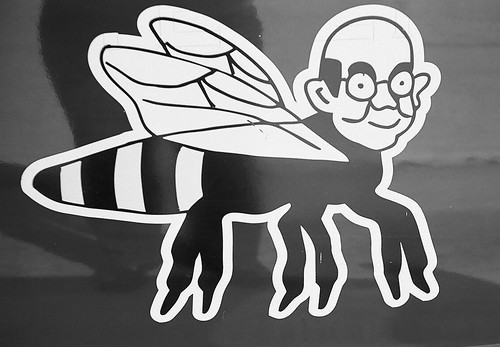
The Bee Man drives a red truck, with an amusing and memorable logo designed by local sign-painter John Alvey—it’s a bee with a man’s head. When on a call to remove a hive, Rogers uses a veil to cover his head, but otherwise works with bare hands. I ask him if he gets stung ever. “Sometimes quite a few and other times not at all.”
Rogers shows me how he collects the bees with his bare hands, with gentle and slow movements. It’s not unlike how people might respond to your movements-- a gentle nudge is acceptable, whereas a harsh shove might be taken as a sign of aggression.
“You be gentle to me, I’ll be gentle to you, and we’ll get along,” he explains.
Locy Rogers is preparing his garden for springtime, sowing seeds and tending to the soil. He has onions and garlic already growing, with plans to sow squash, corn, and his famous 4 O’Clocks that will line the fence. He grows a hybrid version with multi-colored flowers. He estimates he’s shared thousands of his special 4 O’Clock seeds with folks over the years, “You’ve heard of Johnny Appleseed? Well, I’m like Locy 4 O’Clock-seeds!” Rogers is a real gem of a person -- cheery, straightforward, generous and full of life-- a genuine local character. Though his bee rescue dance-card is full most of the year, he asked me to publish his phone number for folks who need his assistance.
His card reads “Bee Happy!”
Thanks Locy!
To contact Locy, please call (928) 634-5937.
Ellen Jo Roberts is not allergic to or afraid of bees, though she is not too fond of wasps, hornets, or those damn “no-see-ums”. She lives in a historic brick bungalow in Clarkdale, with Bike Daddy Chad, several killer dogs and one noisy big-mouth cat. You can read all about it at Ellenjo.com

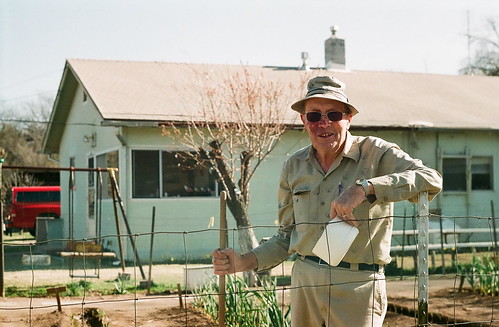
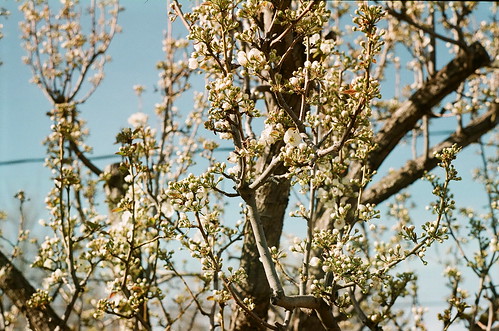


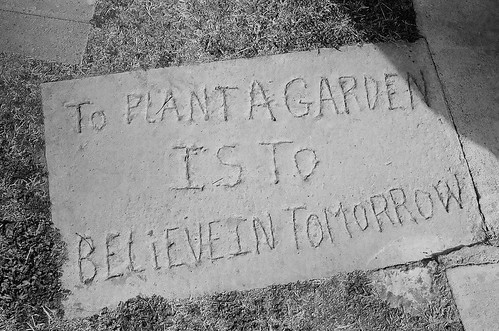
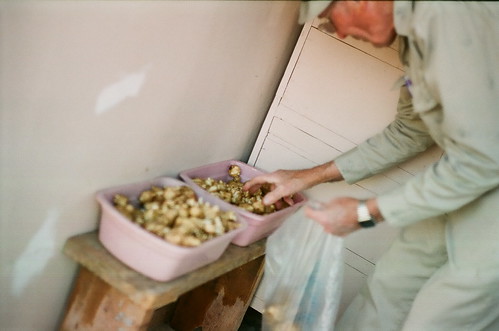
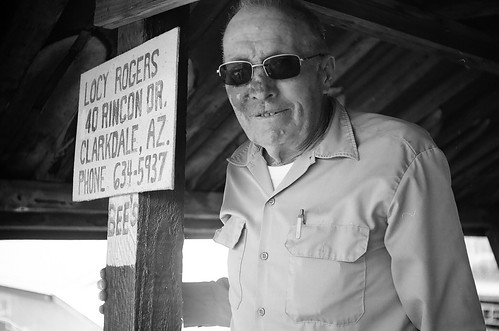
My wife and I visited Cottonwood this week, escaping the heat of Yuma for a few days. The escape was nice.
ReplyDeleteWe happened upon Clarkdale, I was wowed by the brick homes, the small commercial district and the town square. I was remined of a Twighlight Zone episode, the man that finds Mayfield, something like that. It was so quiet and pleasant after the sprawl of Cottonwood.
At home I did a Google search of images from Clarkdale, I saw a handsome fellow, the Bee Man, and read your blog. I then read about the Clark Mansion, what a shame. I don't covet what the rich own, but I do enyoy the look of what they might have.
I hope you don't mind if I follow your blog, stranger that I am, your writing is informative, I want to know know more about your town.
Hi John- Thanks for your nice comments!
ReplyDeleteHa, yes, stumbling upon Clarkdale is exactly like that Twilight Zone episode you refer to.
I am happy to have you follow this blog.
Thanks again.
ive got a hive need bee removal please help
ReplyDelete